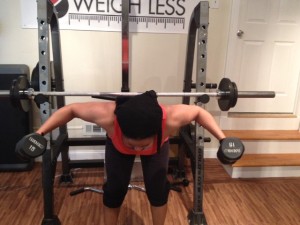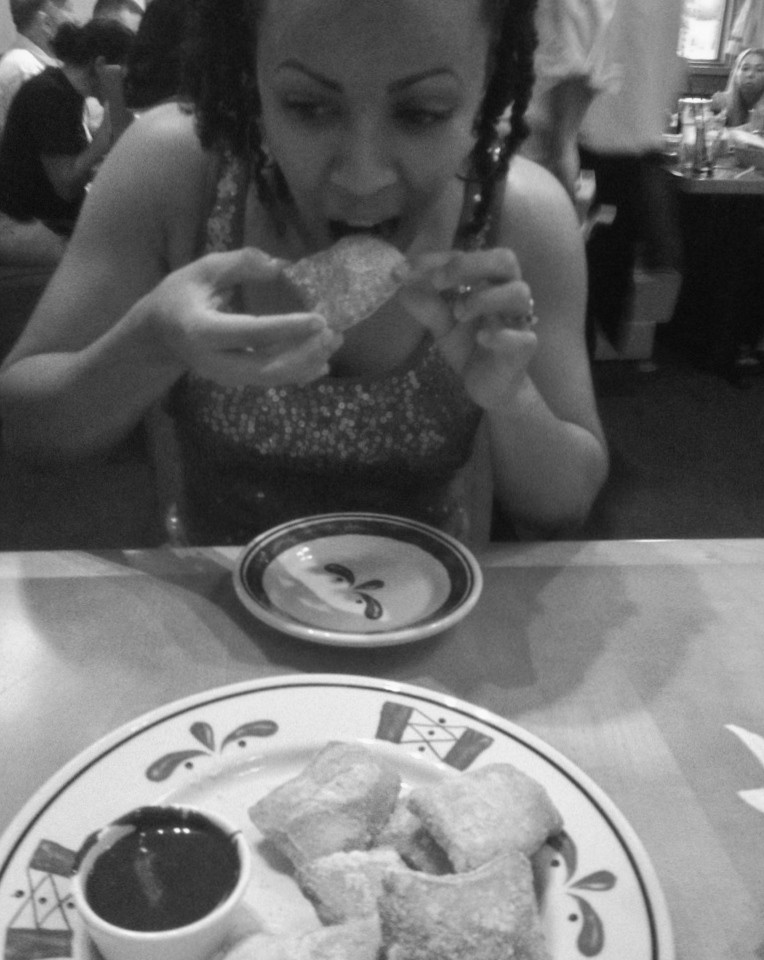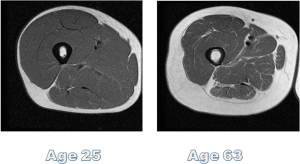
by EM2WL | Jul 31, 2013 | Consistency, Fat Loss / Cutting, Increasing calories, Q & A
Q: I’m confused. Some people who are EM2WL say they zig zag their cals, but yet they tell newbies to eat the same thing everyday. I think one of your videos even says not to zig zag cals. Which one is it? Is zig zagging calories bad somehow?

Is it high carb day yet???
A: You’re right, we have published a few articles and vids that caution people to hold off on zig zagging calories straight out of the gate (first few weeks). EM2WL gets a lot of newbies who are recovering from an Eating Disorder (ED) or ED-like mentality, as well those who are not fully convinced of the process. So we will often recommend to those who are new and coming from extreme deficits that zig zagging calories can send their body mixed messages. (Much of EM2WL research is rooted in ED recovery — including severe caloric restriction — as well as metabolic damage).
This isn’t so much that the zig zagging itself is an issue (zig zagging that centers around TDEE is a good thing). The issue is that when people who have not fully grasped the EM2WL philosophy decide to “zig zag,” they tend to do so drastically (i.e. 3000 one day, 1100 the next, unlike your more sensible zig zagging). Because of this, their body will view it as binges, and then holds on to the extra from the high days. Many will use the “zig zag” concept as an excuse to be only “half-in” — they will eat more a few days per week, randomly, but still net below BMR on other days. Then they bloat, retain water, feel sick, or gain weight, and blame EM2WL. Their body never fully grasps/trusts that they are going to feed it properly (or regularly) and reacts accordingly.
Because of this, they don’t trust that eating more will “work” for them, and they run back to low cals.
Eating as close as possible to their new calorie goal (with enough carbs, and far enough above BMR), for the first few months, will help many people to avoid this scenario. Choosing to stay consistent in the beginning helps:
- newbies accept the mindset of eating more
- ultra restrictive dieters to get used to netting above BMR
- those who need more time, room to slowly get cals/carbs up to a reasonable level (rather than jumping 1000 cals up, bloating like crazy, getting scared and quitting)
- under-nourished bodies to adapt and accept that their caregiver will eat enough,and be willing to let go of the extra that it’s been hoarding due to fear of starvation.
When a person incorporates zig zagging calories or other methods later in the journey, they will likely still eat enough overall cals, and their body will have no prob with the higher/lower cal days, because they are still within reasonable range.

What?! You’ve never had an “eat-all-the-food” day?
Make sense? I know that zig zagging is a big key for many veterans in the EM2WL fam, so we don’t want to minimize, shun, or call it “bad.” However, when we are dealing with such a wide variety of people, we try to suggest the safest method possible for everyone. The lack of consistency in eating the right amount (and types) of cals is what actually hurts many in the beginning if they aren’t smart about it. But, once most people get used to eating enough, vets find that they naturally zig zag anyway:
- they have have learned to listen to their body – and understand that some days will simply be “eat-all-the-food*” days – so they just take a TDEE day (highly recommended)
- many find that they are hungrier on workout days (especially lifting!) & they eat back exercise cals or increase carbs to re/pre-fuel
- many don’t log their workouts, so depending on the burn, their net cals are different each day, and they purposely eat according to the level of activity that day
- many move toward a lifestyle of no longer logging their food (which is the ultimate goal), and follow their innate hunger cues (once they can be trusted again)
- they feel NO guilt for doing so, because they understand that eating for fuel must coincide with life, and that restriction when ravaged with hunger only leads to a binge later
Basically to keep the process as simple as possible, we just say eat the same thing every day until you and your body have adapted to the fact that you will be eating more from now on. Once firmly rooted, adjust to your lifestyle. When coaching so many people, keeping it basic/simple helps a TON, because everyone’s lifestyle is so different. Some prefer zig zag, but others despise it because eating exactly the same works best for their schedule.
It’s all about making it work for you.
*”Eat-all-the-food” days are exactly as they sound: days where you feel like you could eat the house. It’s best not to fight your body on these days and force a cut. Restriction typically begets binges. Give yourself a full TDEE day, and allow yourself to eat up to, and even over TDEE. You will likely find that you not only prevent yourself from a major binge later, but that by simply giving yourself permission to eat, you may not be as hungry as you thought. And hey, if you truly are that hungry, at least your body knows that it can trust you to listen.
by EM2WL | Apr 18, 2013 | Metabolism Reset, Q & A, Reset

Q: I lost around 30lbs very quickly by doing over an hour of cardio/day, 7 days/week, and severely restricting calories. When I hit a plateau, I increased cardio further and decreased cals to lose the last 12lbs. Eventually 15 of those pounds came back. I found out about EM2WL, and began a reset, and I’ve gained a LOT of weight. Is being up 20 pounds ‘normal’? Is it normal to lift and not fit into any clothes? Am I eating too much and that’s why I feel so bloated and puffy? I’m just at a loss and feeling pretty down on myself. I’m right back where I started…
A: As much as I hate to be the messenger…yes, it is normal to be gaining weight during reset. Because you were undereating for so long, it takes a while for your body to regulate (which is why we recommend metabolism resets). When we diet using extreme caloric deficits and excessive cardio, the weight that is lost comes not merely from fat, and water, but also from muscle, joints, tendons, ligaments, and brain tissue. We also deplete our bodies of much needed vitamins and nutrients. So when we increase calories, coming from an extended period of undereating, our bodies will often first retain everything, assuming that this is merely a binge. During this period of retaining, your body is seeking to replenish the nutrient deficit, as well as balance out mineral deficiencies. As noted in the Biology of Human Starvation (see our synopsis), a period of OVERfeeding is often necessary before proper balance is restored. Because most people just starting out on a reset are petrified of eating more, this re-feed period is a bit understated. Many will only eat the bare minimum (TDEE) and often undercut/skew that amount, for fear of gaining. But recall that Dr. Keys made it clear that during a refeed, calories must be in abundance in order to rehabilitate properly. This is why many choose to use their reset as a period of bulking, to purposely overfeed and rebuild lost bone and muscle. This gives their reset purpose, and helps them to have something to focus on other than waiting for the cut.
None of this means that the reset process is exceptionally pleasant, although you will surely notice some unexpected benefits. You will feel bloating and discomfort as you retain water while your body is forced to figure out how to gather the nutrition it needs while digesting larger amounts of food properly. Once your body understands that proper nourishment is a mainstay, it will then look to replenish the areas that have been depleted. The rebuilding process is necessary and essential to your well-being. However, weight gain can be less drastic when food intake is increased slowly, and done for a much longer, realistic, time frame. Rushing the reset is often the cause of unnecessarily high weight gain, causing one to quit early, and results in an unsuccessful cut. Skipping the reset altogether is also a reason why you’ll see many struggle in the beginning of their cut.

Treat your reset as a bulk. Put those extra cals to work building muscle.
You are lifting heavier now, in addition to eating more, which will assist in rebuilding any muscle that has atrophied. Exercises that create strong muscles will also increase bone mass. Healing will always be your body’s primary goal (unfortunately, it doesn’t really care about your physique goals), although some fat loss may be happening simultaneously. As the body begins to rebuild the muscle/bone/brain tissue, etc., this will show as “gain” on the scale. But you will have so many things going on that solely judging by the scale will not give you the full story. This will seem very frustrating at first, but you will still likely notice positive changes in the mirror, pictures, and the tape measure during this time. As the rebuilding slows, you will eventually see scale movement as well.
It is most important to remember that what you are dealing with now, is what you would have dealt with anyway, the minute you tried to eat “normal” again. The fact that you are gaining weight on what should be your maintenance level calories, shows that your metabolism had completely slowed to meet the lower calorie level. This is the point of the reset. This is something that you were bound to experience, regardless. In order to keep losing, you would have kept lowering cals and slowing the metabolism further, constantly recreating your maintenance level. This means that anytime your calorie intake exceeded this level, you would gain.
So for some, the first 4-6 weeks or so may bring gain and then a gradual release as the body gains trust. But for those who have drastically undereaten for a length of time, this process can take longer. This is especially true if someone needed a reset, yet refrained from taking one (the body will attempt it’s own reset by simply resetting to the cut level calories being given). We must always remember that when we chose drastic measures to lose weight, there will be consequences. Losing the wrong “type” of weight, just for the sake of seeing the scale move, tears our body down and causes it to lose trust in us. A body that does not trust us is left to it’s own devices to nurture itself, deciding what will stay (fat) and what can go (muscle, etc). It also means that the loss was not true. When a loss is not true, it is essentially temporary, and we can typically expect to gain it all back…and more.
The #1 reason that weight gain during a metabolism reset is surprising for most of us, is because we forget that it’s only ONE phase of the journey. The Reset Phase is about healing, not fat loss (that’s a whole ‘nother phase!). For more info on the 5 phases click here.
SaveSaveSaveSave

by EM2WL | Nov 5, 2012 | Building Muscle, Increasing calories, Q & A
Q: Why do you want be able to eat so much? Why would a woman purposely go through “bulking phases” trying to gain weight for the sake of adding muscle? I mean, you are a woman, why do you want to eat like a man and look like one too? Just sounds like gluttony to me. I’m completely content eating less than my husband, and having less muscle.
 A: I’m sorry that you see it that way, or that I come across as a muscle-bound “glutton” to you. It’s not just to be gluttonous …OK, maybe a little, lol…but more so because I know how much our metabolism slows with age. Weight goes up, muscle and bone mass decrease, and we have to eat LESS just to accomplish the same results. Everything that I do, is to DEFY that trend. So my aim is build as much muscle, and eat as much food as I can now. Then, when I get to the age where my peers are hardly eating, getting “softer,” and at higher risk for bone/muscle loss – I can still enjoy my life and have enough bone/muscle/brain strength to have as much independence as possible. This is very important to me, as I watch my own grandparents age and lose all independence. I am a very “future” focused person, in case that isn’t obvious.
A: I’m sorry that you see it that way, or that I come across as a muscle-bound “glutton” to you. It’s not just to be gluttonous …OK, maybe a little, lol…but more so because I know how much our metabolism slows with age. Weight goes up, muscle and bone mass decrease, and we have to eat LESS just to accomplish the same results. Everything that I do, is to DEFY that trend. So my aim is build as much muscle, and eat as much food as I can now. Then, when I get to the age where my peers are hardly eating, getting “softer,” and at higher risk for bone/muscle loss – I can still enjoy my life and have enough bone/muscle/brain strength to have as much independence as possible. This is very important to me, as I watch my own grandparents age and lose all independence. I am a very “future” focused person, in case that isn’t obvious.
I just grew up originally thinking (as did my grandparents) that the changes we deal with as we age are inevitable. While some of them may be – and we will never be immortal – studies are proving that much of what we’ve attributed to “the effects of aging” over the years, are simply the effects of being sedentary. I WISH my grandparents only had known that they needed only to eat a bit more, move a bit more, and lift a little weights. Heck, I wish they’d even try a little now. I watched them give up at the first sign of “aging” almost 20yrs ago! My grandpa plopped on the couch in his late 50s and basically said “that’s a wrap, I’m too old.”
Unfortunately, he has stayed there WELL into his 70s.
Grandma has followed his lead and she’s still in her 60s. It makes me so sad. I don’t expect them to be flipping cartwheels or anything, but they’ve incurred more muscle/bone loss since they STOPPED moving/eating, than they had up until that point. I didn’t think they had a choice, but now that I devour studies on aging, I hurt knowing what they don’t. It’s tough to know, yet not be able to say anything out of fear of being disrespectful. But all of the kids/grand-kids talk. They talk to one another about how much it hurts to see Papa just decide that he’s “done” and constantly reference his mortality when we are with him. Its very depressing. I mean, if you still have to be here, why not try to make your life the best it can be?
I’m not afraid to leave this earth, but I don’t want my grand-kids to watch me “give up” on life 20, 30, 50 years before my time.
But, that being said, I do know that a lot of people believe that if they are comfortable with their calorie intake/level of muscle now then why bother? On some level, I get that. Without the long term aspect in mind, it does kinda seem pointless to some people to raise their calories/build muscle if they feel “satisfied” now. My issue with that standpoint is that what satisfies me now, may be too much 10 years from now. So if I’m already eating a miniscule amount, it will need to be decreased even further. The muscle that I have now, if left as is, will be but a fraction of the current amount, when I need it most. So, for me, it all comes down to being safe rather than sorry, and getting those calories and muscle mass to a decent level…now.

MRI cross-section of a male thigh – notice how the muscle/fat ratio changes as the decades pass? Males carry MUCH more muscle than women.
How about you? Do you feel that EM2WL is just an excuse for gluttony? Is it greed to want to eat more, when your body has adapted to a smaller amount of food? Should women leave the “muscle building phases” to the men?
by EM2WL | Sep 26, 2012 | Building Muscle, Q & A
Q: I’ve just been so confused. I have been shrinking and really don’t want to get any smaller but my lower half of my body is still very squishy and not toned. Would that mean I need to do cardio or just lift more on my legs? I have those dreaded saddle bags that stay on me till I weigh as much as a toothpick. I weigh 110 right now with around 20% body fat. I don’t know if I could handle a month cut? Sorry for all the questions. I am just tired of not seeing any results.
A: Wow, you are so small already, cutting doesn’t sound like it will help with the look you’re trying to achieve. I’d say it’s time to up the weights in the leg work. Doing more cardio at this point will just create the “skinny fat” look, which is what you’re trying to avoid/overcome. Building muscle will firm the legs up quite nicely. So you could go straight into a bulk, and develop some lean muscle under the layer of fat that may be there now. Because of this your legs may feel like they’re getting bigger at first (because muscle is developing under fat), but pay close attention to the firmness. When they seem firm enough (or if your pants get too tight) cut for 3-4 weeks (or until pants fit again, lol) and then go back to bulking. This will slowly get rid of the “skinny fat” and give you firm, shapely legs and glutes.
A few must-haves in your leg routine would be heavy squats, lunges and deadlifts. Stick to free weights/compound movements, don’t even bother with the weight machines, if you can help it (unless you’re very new to weights and still learning proper form. But eventually wean yourself, or sprinkle into your free weight routine).
Also see if you can incorporate 2 leg days into your routine, 1 heavy and one light (the lighter weight/high rep day can replace a cardio day — or, alternatively, use a cardio machine like the stair mill on cardio day).
Even if you choose not to bulk now – opt to eat over maintenance (~ 200-300 cals) on leg day.
Q: Yes! It’s that awful skinny fat on my legs! Everyone says cardio, cardio to get rid of it. My thighs are 19 1/2 inches and still fat. One of my friends refuses to lift weights and tries to get me to run with her a few days a week. I hate it! She wants me to run a 5k with her but all I can ever think about is how it’s cutting out my time at the gym.
A: Nooooo! Now is NOT the time for a 5k, ROFL. Excess cardio is what creates the skinny fat, not what heals it. Not to mention the fact that you say you “hate it,” why torture yourself unnecessarily? As you develop the muscle you desire in your legs, you can carefully use your runs (or preferred cardio) to help with extra fat. But too much will tear down the muscle that you’re trying to build and become counterproductive. If you force your body to choose between building muscle and endurance, endurance will typically win. This is especially important — unless you are training for a marathon/triathalon/etc. (in which case you would want some muscle atrophy in order to run faster- too much muscle makes you slower) — since you actually want muscle in your legs. If you wanted to incorporate cardio that will help you reach your goal, shoot for things like the stairmill, bleacher runs, sprints, etc., NOT long distance running (at least not right now).
Girl, adding squats, deadlifts, etc. was the best thing that ever happened to my cellulite, lol. Weighted leg work is the real deal when it comes to shaping the legs.
by EM2WL | Sep 4, 2012 | Metabolism Reset, Q & A
Q: I have a confession.
Its been 3 months, I’m up 10lbs and I couldn’t have gained 10 lbs in muscle. I cannot handle this anymore, is EM2WL for everyone? I didn’t go through over a year of hard work to slowly go back to where I started.
I’m trying to stay positive, I’m trying to promote EM2WL but I’m getting sick and tired of it and ready to give up.
I so badly want to go back to my 1200 calorie diet and 2 hours of cardio, regardless of all the articles opposed to it.
A: Ugh! I feel your pain at seeing the scale creep up 10lbs — really, I do. It seems so contradictory, and if I were in your place (and still at the beginning of my journey) I would feel the same way, and would probably look at someone saying what I’m about to say as insane. But having lived to see the other side of it, I can tell you from experience, that 3 months is NOTHING in the grand scheme of your entire life. Especially if you want to win this battle once and for all.
But, as for troubleshooting the gain (which I’m sure is the only part of this that you’ll even WANT to hear, lol):
- How much cardio are you doing?
- What types of workouts are you doing, and have the workouts been the same the whole time, or changed?
- When was the last time you took a rest week?
- Are you weighing yourself under the same conditions every time (couple days off of lifting, moderate sodium, etc?)
- Is there something in your diet, in particular, that has increased that could be causing extra bloat water retention (dairy, wheat, gluten, etc)?
I know how frustrating it can be. It took me so many months before my body got back on the right track, that I’d pretty much given up, too. And not trying to scare you off, but…I gained back every.single.pound that I’d lost up until then.
Straight up.
This is not always gonna be a numbers game, and you may not always be able to “explain away” everything that happens on the scale. There are always so many variables, that honestly, you shouldn’t even try. Trying to make sense of every single pound that is away from a certain number will drive you insane. Personally, I know that I can hold up to 10lbs of water weight, at any given hormonal moment. I would love for it to only be 2-3 like some ladies, but I just don’t get that kinda luck. We are all about the real deal here. I’m not gonna sugar coat it and say to that you may not keep that 10lbs or that all the weight is gonna magically fly off. I’m also not saying that it won’t happen, either. But I will say that stressing about it will literally make the problem worse, while not changing the logistics of what must take place here.
This is a mental battle. All mental. If you can stay strong in MIND, the rest can, will, and DOES fall in to place.
A few things to realize:
1) I’m exactly the same size that I was at my “fattest.” Right now. But I’m about 5 sizes smaller, and look 10xs better (if I do say so myself, lol)
2) We tend to get frantic when we start “gaining” during our reset and such, but typically any weight that is gained during the reset is the EXACT amount that you will gain ANYWAY, regardless of if you rode out 1200 cals until goal or did the reset. That’s because if you ride out 1200 cals, get to “goal” then start eating normal, your body will still have the same reaction. Much better for your body to do the adjusting NOW, and see what you’re really working with, than to be deceived by the false sense of security that low cals gives. Most people don’t understand that when dieting, they would need to actually go 5-10 lbs below what they think goal is, because once they get to “goal” they have to allow for weight fluctuations that happen to EVERYONE when they get there. Check out the difference in the weights of former Biggest Loser Contestants. How many stay at the exact weight that they “ended” with?
3) If you do drop back to 1200, then hit a plateau before getting to goal, what do you do? Drop even lower? That is just so unhealthy, and I would pray that you would not let the scale have that much dominion over you. I know that it’s hard to get to that point, mentally, where you don’t care what the scale says, but it really cannot be your only dictator.
4) Studies have shown a very strong link between delaying gratification and success in life, so look at the ways that this journey will help you in ALL areas of life, not just how you look on the beach this summer. How’s that for multi-tasking?
“Going back can sometimes be the quickest way forward.” C.S. Lewis
by EM2WL | Aug 22, 2012 | Nutrition, Q & A
Q: Protein shakes and bars don’t seem to agree with me…or, at least not those around me, if you get my drift. I’m trying to up my protein and I was wondering what type of protein shakes and others sources you use? Do I just need to deal with the uncomfortable feeling? or will I “outgrow” it? Any advice for sensitive tummies?

A: I have a sensitive tummy when it comes to protein supplements, so I literally feel your pain.
For starters, try including more “whole” food proteins, like meats & fish (fresh, frozen, dried, canned, veggie), dairy (milk, yogurt, cheese) nuts and nut butters, seeds (sunflower, flax, chia), beans (edamame, black, pinto, red, etc), eggs, soy, tofu or even grains like quinoa. These (and any whole food proteins not mentioned) should make up the bulk of your protein intake, whenever possible.
I don’t do too much “fake” protein, lol, for exact reasons that you’ve mentioned…it just doesn’t agree with me. I’ve learned that my body (as well as many women with more sensitive tummies) can only take so much protein at a time when it is detached from the “source.” For instance, I have no problem digesting 30g of protein from a large chicken breast, but 30g of un-pronounceable protein in a bar? Forget it! LOL. Same with yogurt, if you’ve ever noticed the clear liquid that sits atop natural yogurt, that is whey. I can stomach that whey just fine, but separating it from the source, and quadrupling it? Not gonna work, lol. It’s just too much at one time. If you’ve ever sought out “womens” protein powder, you may have noticed that they’re typically lower in protein, and that is why. Many women can’t tolerate the huge 40g+ scoops that the guys buy (although I do envy my girlfriends with iron stomachs – they can take that 40g to the head, no questions asked). If I know that I will fall short on my protein goal, and Hubby’s protein powder is my only option, then I add only a half scoop of the powder to my shake. I know from experience that any more than that, and I will feel sick all day, and it’s just not worth it.

 Whenever I purchase a convenience protein item, especially one containing whey, the key is getting the ones lower in protein than the others. So for bars I stay around 10-12g, and shakes 18g or less is what I’ve found works best for increasing protein without “offending” those around you, lol. So if you want to use protein supplements, you may wanna try lowering how much you take at a time, and see if that helps.
Whenever I purchase a convenience protein item, especially one containing whey, the key is getting the ones lower in protein than the others. So for bars I stay around 10-12g, and shakes 18g or less is what I’ve found works best for increasing protein without “offending” those around you, lol. So if you want to use protein supplements, you may wanna try lowering how much you take at a time, and see if that helps.
So, how does that help you if you are trying to increase your protein intake? I’ve found that combining it with a “real” food source helps my to body digest it better. Kinda like stirring that whey back into my yogurt or cottage cheese; essentially adding the whey back into the source. I’ve also noticed that adding fat to protein powder helps it to go down a bit more easily (which is where the stomach issues stem from, it digests SO fast- fat slows down absorption). So I’ve learned to take advantage of these concepts. Whenever I have a protein shake (using the 18g or less powder), I include milk, soy milk, yogurt, or something else that has some protein (and preferably, fat). That way I still get a pretty high dose of protein, but not all from “fake” stuff, plus the addition of fat to help my body tolerate it all. Peanut/Almond Butter make regular appearances in my protein shakes due to their protein/fat combo (PB2, known for cutting the cals by removing the fat, will not sub for this purpose).
I love fruit smoothies, and although I’ve noticed that the fiber from fruit does help, simply adding a banana (or other fast digesting fruit), will not produce the same effect. If you want to include fruit, that’s fine, but don’t forget the fat. There are several healthy, yummy types of fat, like flavored fish or coconut oil
or coconut oil , or chia/flaxseeds to add taste, texture, and nutrition to your smoothies.
, or chia/flaxseeds to add taste, texture, and nutrition to your smoothies.
If lack of time/location prohibits you from being able to add items to your shakes, then seek out powders or bars, that include the above recommendations, and avoid those that don’t. Sometimes, the problem may lie in a quick fix, such as: switching to a lactose/dairy free brand, or one that includes digestive enzymes, or simply lowering your dosage.
I hope that some of those suggestions will help you. But remember, always try to get the majority of your protein from real food. Let the supplements do just that – “supplement” what you’re already eating.
Anyone else found ways to deal with this issue?











Recent Comments